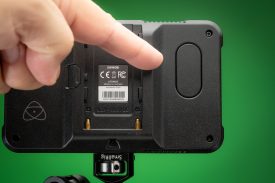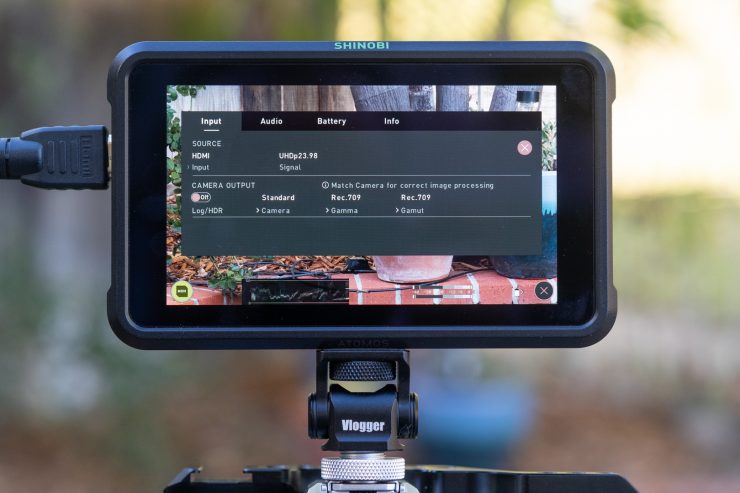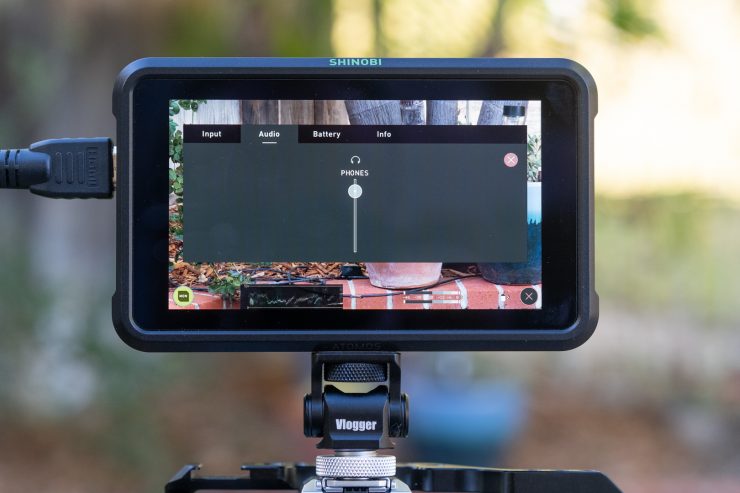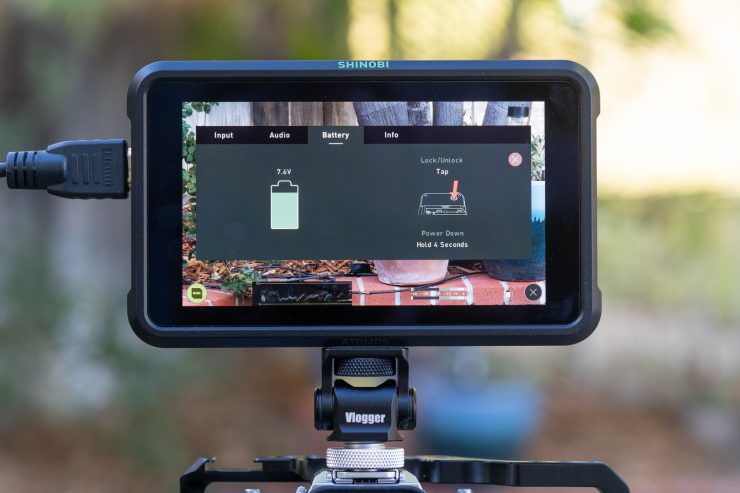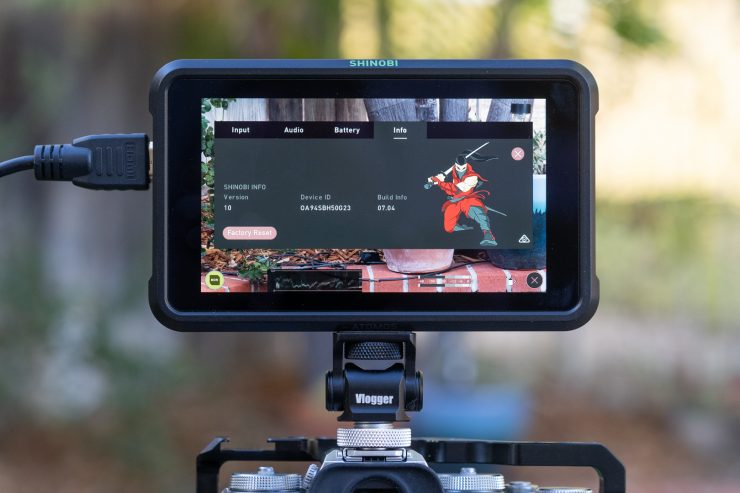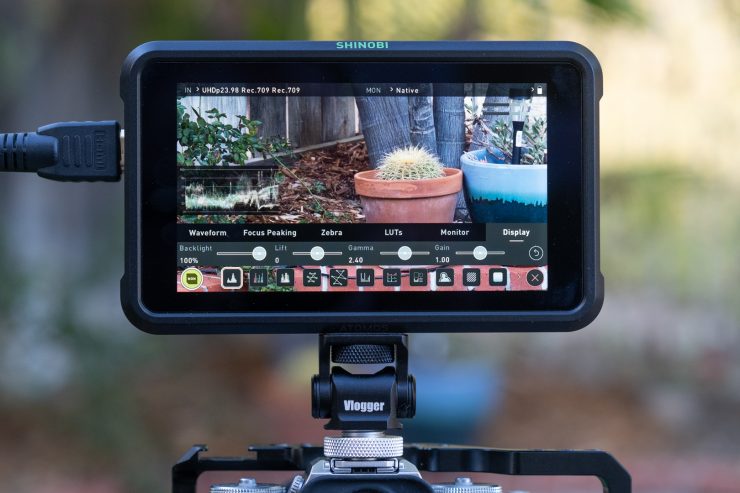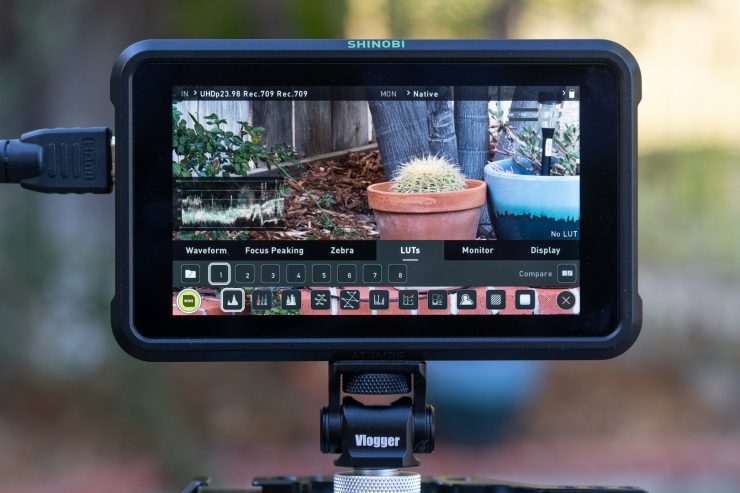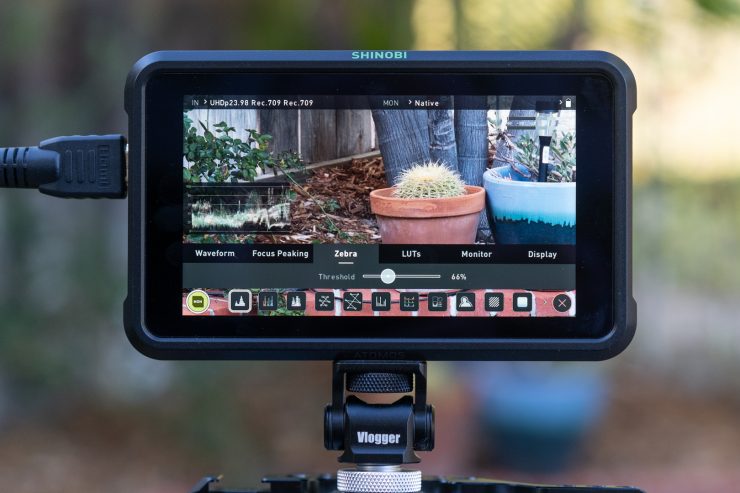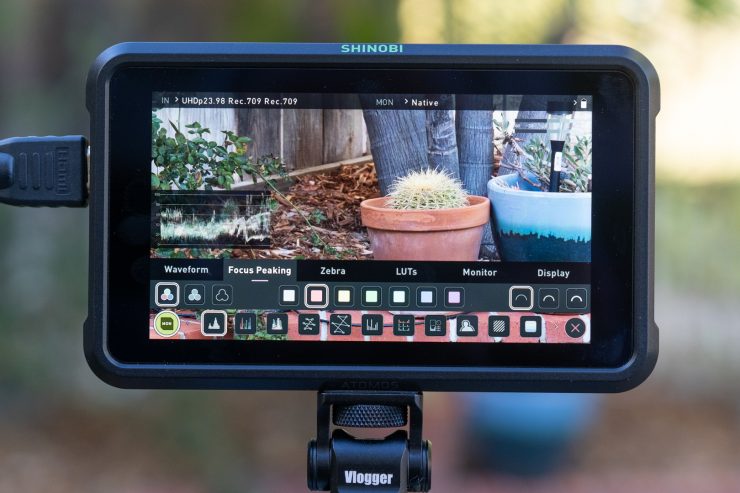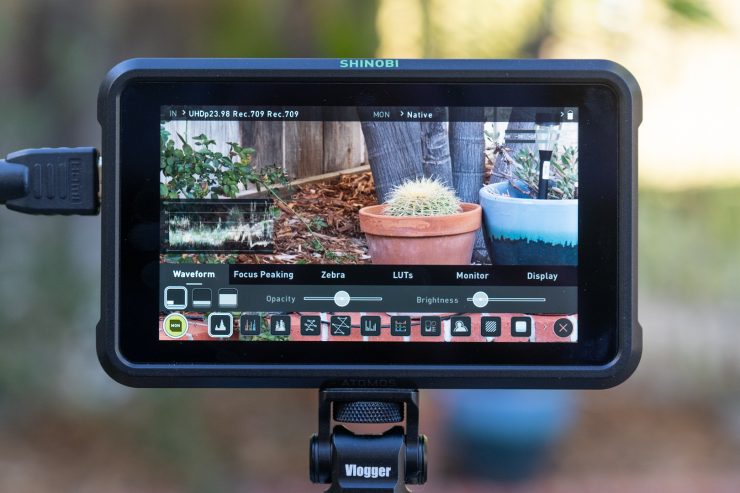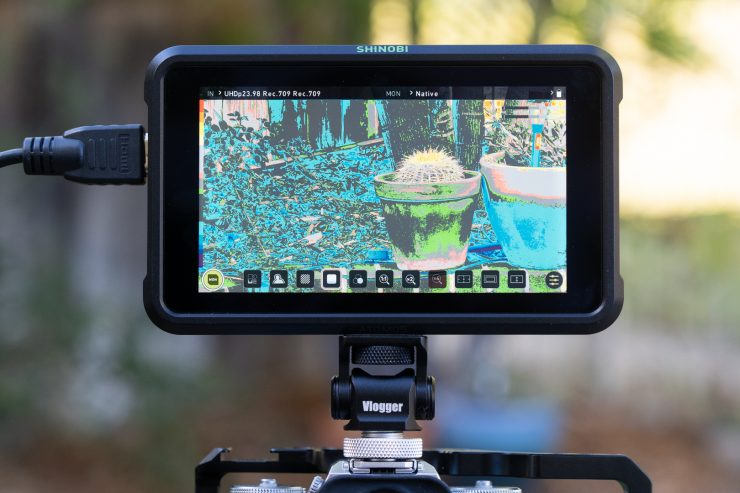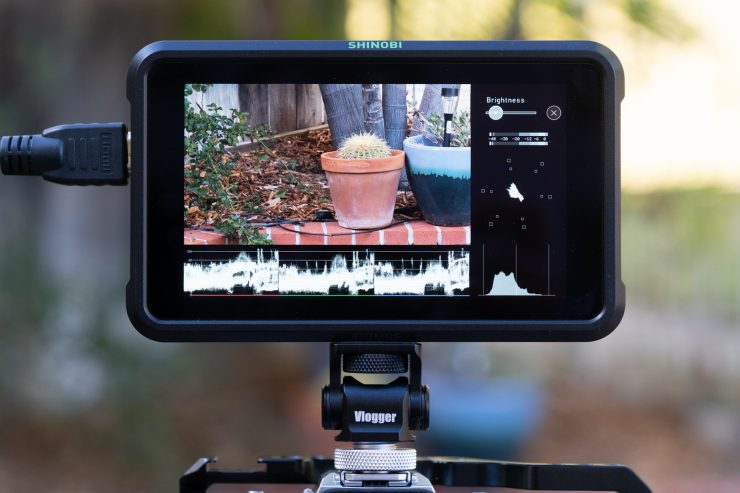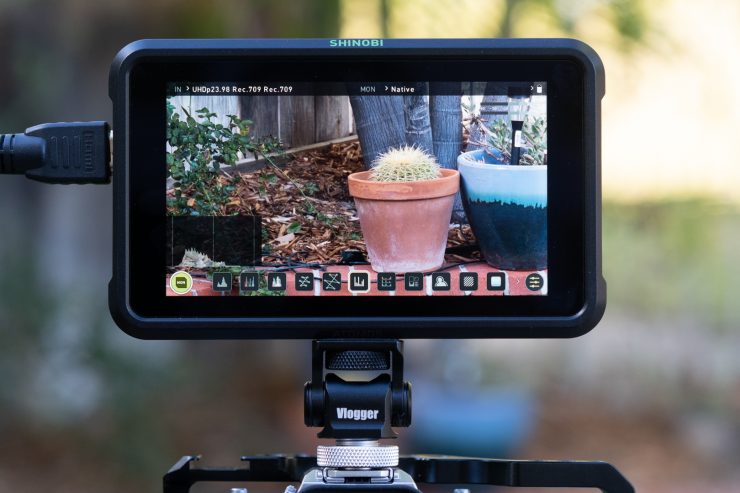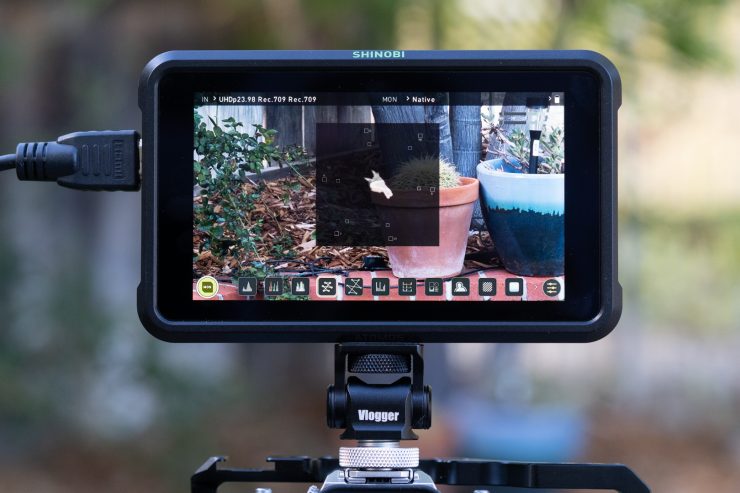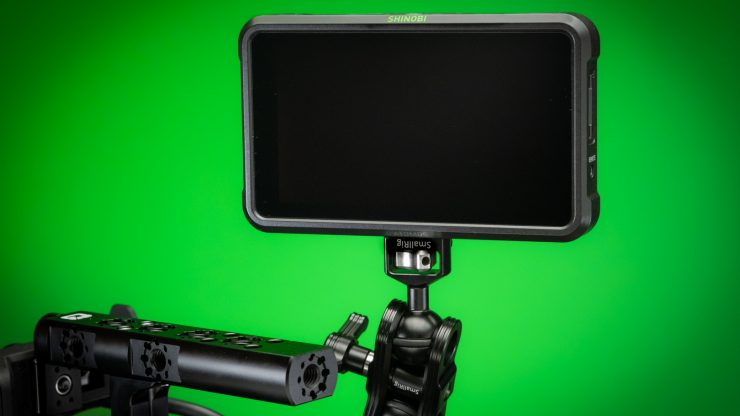
I started writing this review prior to the SDI version being released. However, I did notice early on that on the back of the Atomos Shinobi was an interesting cutout that looks like it could be used for another feature. Well, that ended up being the SDI in/out. Many professional cameras with SDI also offer HDMI for monitoring in HD. Now that the Atomos Shinobi has an SDI model the question is is it good enough for pro use?
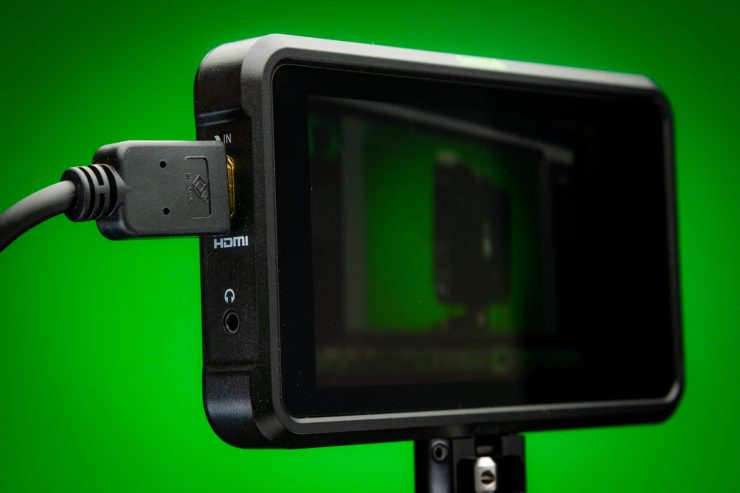
When I first pulled the Atomos Shinobi out of the box I was taken back by how light it is. With the all Polycarbonate ABS body it’s so light it feels like something is missing. Oh yeah, the recorder!
Check out Matts full review of the Ninja V. It’s very thorough. Also my initial post on the release of the Atomos Shinobi and SDI model
Atomos wanted to make the Shinobi a monitor that is easy to use with smaller mirrorless cameras and keeping it light is a big factor on using it for vlogging and on the go content creation, also for gimbal use adding a lightweight monitor is nice. If you don’t want to boost the image quality that ProRes can give you then why have it. So many mirrorless cameras now have excellent internal codecs but lack a flip-out screen for those times you want to be in front of the lens.
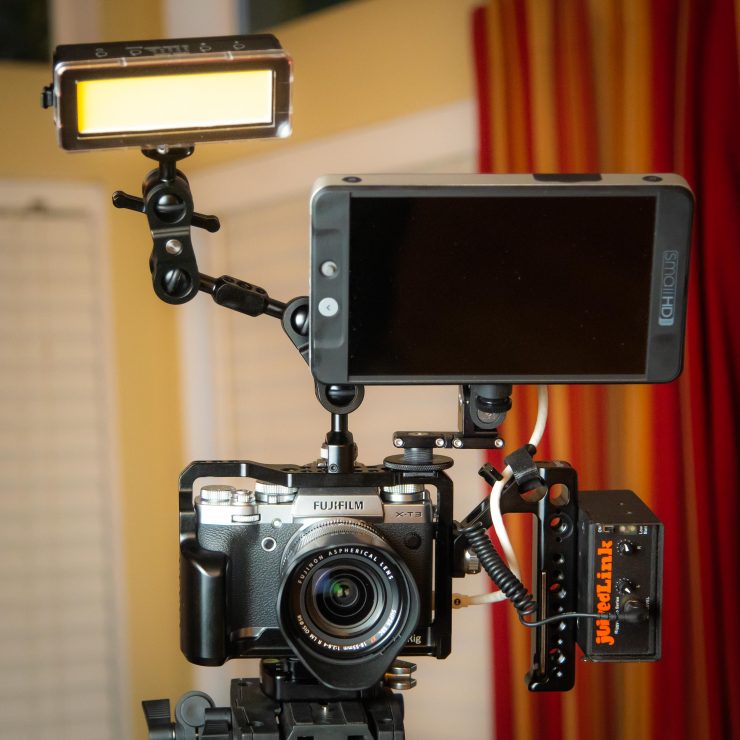
I appreciate the pain a solo shooter has as I too have to shoot myself and the product shots for the reviews I do here on Newsshooter. Vloggers are generally an arm’s length away from the lens while I tend to be three times farther and need to use a monitor for focus, framing and making sure my audio is working. I can definitely see this monitor being used a lot for just this reason alone.
It’s a Ninja V without a recorder
The Shinobi screen itself is very nice. It’s basically the bright outdoor usable 1000nit display the Ninja V has. I don’t have a Ninja V to compare it to side by side unfortunately but I did have a prerelease version to play with and was impressed with the new tools layout and this was the beta version. The official release is even better.
The Shinobi is loaded with tools just like the Ninja V to help us get the shot in focus and exposed correctly. Oh, and with audio too.
Shinobi Tools from left to right on monitor
- Waveform
- RGB Parade in Black and white
- Waveform with RGB
- Vectorscope
- Vectorscope Zoomed
- Histogram
- Histogram With RGB
- Analysis
- Peaking
- Zebra
- False Color
- Zoom 1:1
- Zoom X2
- Zoom X4
- Frame Crop – 16:9, 2:41, 2:35, 1:9, 1:85, 4:3
- Title Safe Guides
- Anamorphic de-squeeze 2x, 1.5x, 1.33x
Not only does the Shinobi have a lot of tools the 1000nit display makes using the monitor outside doable. I feel 1000nits is the minimum needed for viewing outdoors and in sunny locations. It’s as bright as the SmallHD 702 Bright that I use in sunny San Diego. Again all this for only $399 for the HDMI model is just a great deal.
Is it for pro use?
So you might be thinking. Is the Shinobi a monitor for pros? Well, I would say of course it is. In fact, several of my DP friends are buying them because they like the lightweight aspect of the Shinobi and now it’s also available in SDI making it a very handy monitor to have on set. If you are a SteadyCam op and can strip away some weight that’s always a good thing. MOVI and smaller handheld gimbal ops will like a few ounces removed too. If you don’t need a recorder because the onboard codecs on your camera are fine then that’s another plus. Add that the monitor has very good color and HDR with LUT support and a host of tools it’s pretty much a steal for only $399.
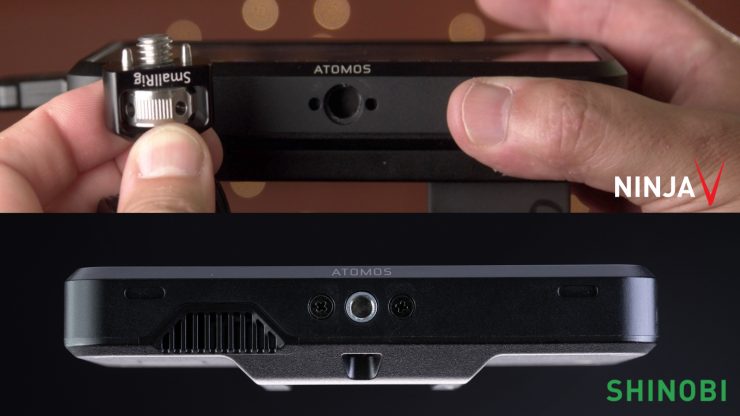
The Shinobi has two 1/4 20″ mounting points. One on top and on the bottom. Unfortunately, the ARRI accessory mount isn’t included like the Ninja V. I really like the ARRI accessory mount as it has two pins on each side of the 3/8″ screw that prevents twisting when mounted. This is such a great design as monitors tend to twist when mounted to a single 1/4 20″. The Shinobi uses 1/4 20″ taps on top and bottom. I would have liked to see the Shinobi SDI model have the Arri accessory mount added back in since more pros with cinema rigs will be using this model over the HDMI only version.
Yes, the build isn’t as good as the Ninja V and doesn’t have HDMI out but it can be used with a Ninja V feeding to it on set so the image matches and others can see the exact same image. I really don’t see any disadvantages other than build. Now, I’m not saying it won’t survive in the production world. If it’s going to be used by others on-set that might not be as gentle as you are with gear then a Ninja V or SmallHD 502 or 702 is probably a better option due to a more robust build with aluminum housing however I wouldn’t discount the strengt of some plastics either.
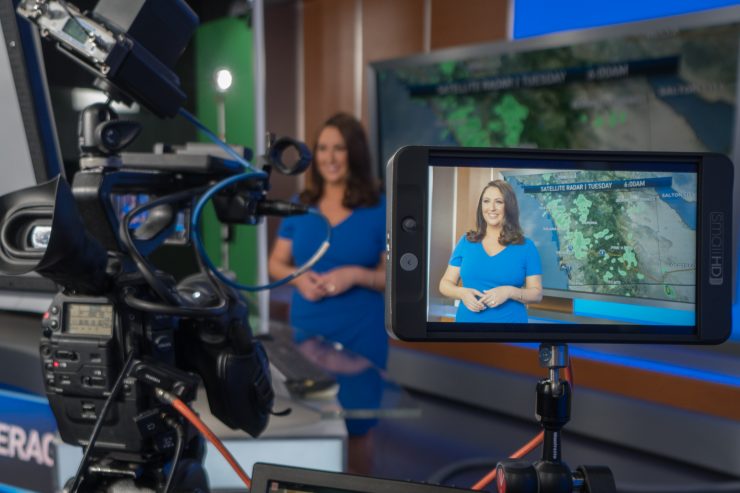
Personally the SmallHD 702 Bright has been my go-to monitor for a few years now. Great battery life and very good tools plus the pages UI is pretty great. The downside is it can be heavy on smaller camera packages and is much more expensive at $1,368.72. The key here is how important the software is for a monitor. I think the GUI is every bit as important as the monitor itself.
I’m not a fan of cheap HD field monitors. Yes, you can get a sub $200 5″ HD monitor on Amazon but the tools and software is crap. I need more than just an image when I shoot professionally. Tools are what I need to make sure I’m getting proper exposure and focus. I haven’t used a cheapo monitor that had decent tools that are easy to access. Trust me software matters and it’s worth paying for if you’re a pro
DEFINITION OF A PRO: engaged in a specified activity as one’s main paid occupation rather than as a pastime.
I’m hanging that out there because the pricing for the Shinobi at $399 is really inexpensive in a pro gear world and the usability is well above its price. These things don’t happen very often.
It’s all about monitoring
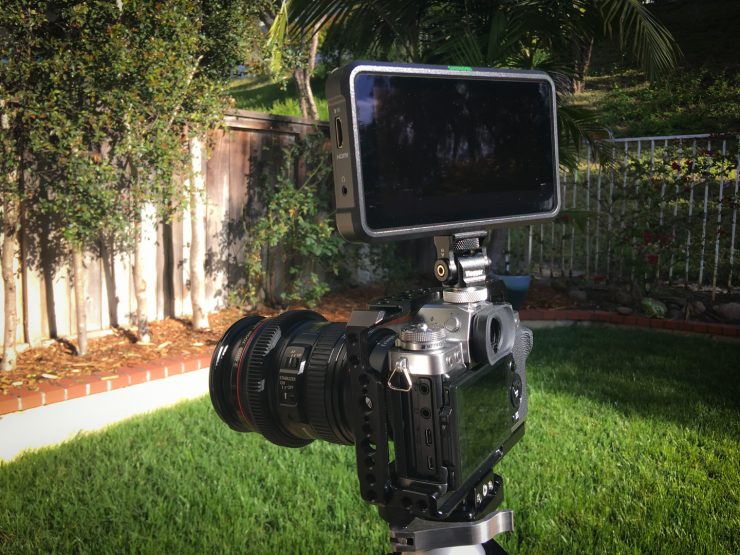
Without the recorder and aluminum body, the Shinobi is very light. With a Sony type NP-F770 battery and small Andycine hot shoe monitor mount, it only comes in at 15.2 OZ it weighs the same as the Canon Speedlite 600EX II-RT flash at 15.0 OZ. Many people including me at times worry about putting to much weight on the cameras hot shoe. I haven’t ripped a shoe off a camera yet so I couldn’t say just how much a camera can handle. I feel it can handle a pretty decent amount however, I know that 15OZ isn’t going to cause any damage at all.
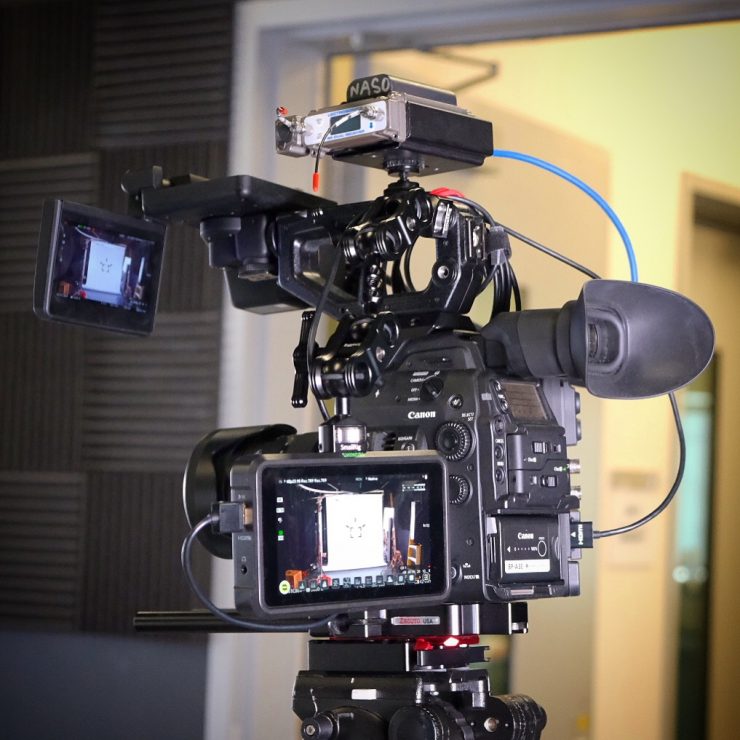
The Shinobi is all about being a monitor with tools to assist us in getting the shot. It uses the same screen as the Ninja V, no sacrificing on the very nice 5.2” 1000nit anti-reflection uni-touch IPS panel. If you like the Ninja V screen you will like the Shinobi too. The resolution is full HD 1920 x 1080 427ppi. It is capable of receiving a 4K signal and displaying it in full HD through the HDMI input. The SDI version is
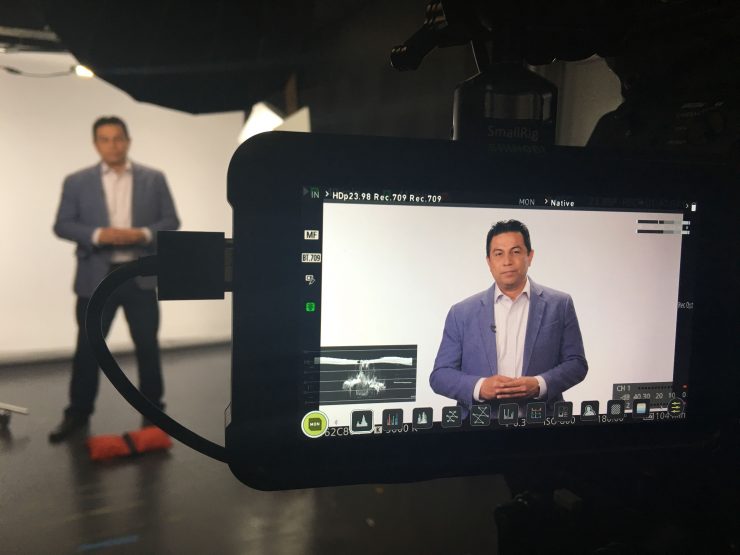
The tools are laid out like the Ninja V. Atomos has done an excellent job refining the software. The new tools were introduced with the Ninja V. It’s an excellent first release and will only get better over time. I’m sure we will
Atomos Shinobi Menu Settings
Accessing tools are limited to no more than two taps. This is huge for a fast-paced production. I despise having to use a series of button and menu trees. How many times have you opened a menu? Navigate to the section you want to open. Go up or down. Highlight and press the wrong button to open the function and have to start over again? It’s like a video game level you can’t beat!
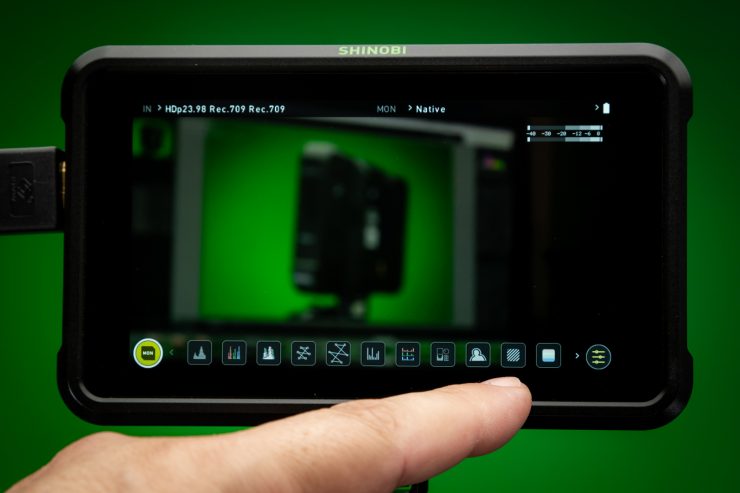
On the Shinobi you tap the yellow icon on the bottom left and the tool options open. Tap the one you want and it pops up. If you want to change the position or size tap the tool and it will enlarge. Easy. One gotcha is the way to access the second page of tools. Yes, there are more. To show them I found a quick light swipe from right to left without stopping while your finger is on the screen works well. While having so many tools available on the screen is great having none on the display is also nice. A quick single tap and the screen is free of all tools.
One thing I noticed is the touchscreen is a little problematic. Swiping and tapping are inconsistent. To clear the menus a simple double tap on the screen does the job however, it doesn’t always respond and I have to tap again. I’m not sure why it’s doing this but feel it’s a bug or I just don’t have the tap speed right. With the menu bar to access more tools, you swipe to the left on top of the menu bar. This has to be performed quickly and not stop at the end of the swipe. If you do stop the Shinobi opens the tool. This can be a little annoying but I’m sure it can be fixed with a firmware update.
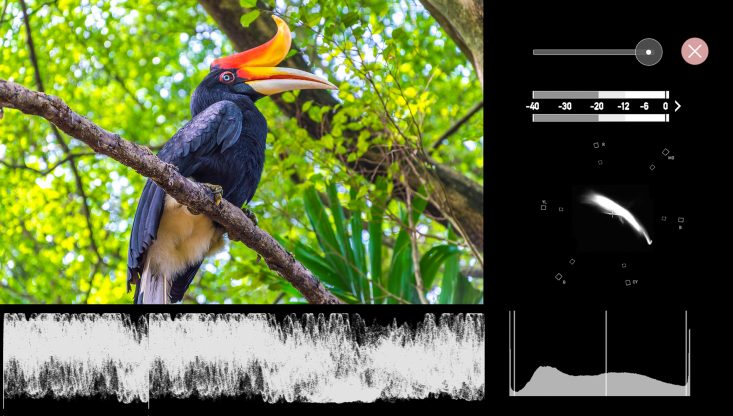
A new tool not available on the Ninja V is the new “Analysis” feature, you can now simultaneously see what you are shooting, view a waveform, histogram, and vectorscope, without the scopes covering the image. As for customizing them you cant change the tool or location but you can change how the tool looks.
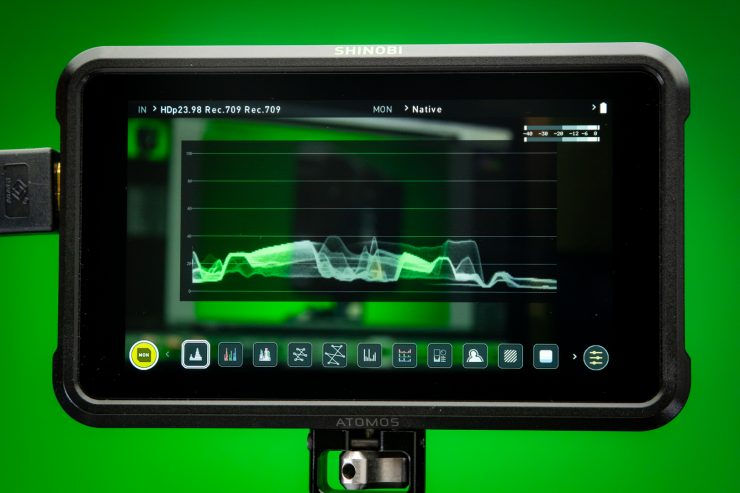
The Waveform with a single tap on the tool icon opens in the corner. Tap on the Waveform and it will get longer. Tap on it again and it goes full. You have options with the Waveform as well. RGB or black and white and RGB Parade. These are very good tools that pros like to use.
For photographers. The Shinobi has a Histogram that also has a color option with RGB.
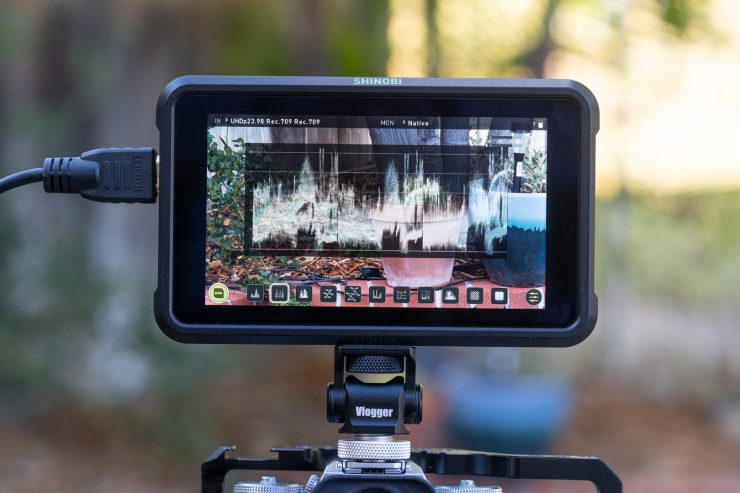
I really appreciate the Brightness Level adjustment for the scopes. I like it really low so the lines are thinner and to me, more precise. It’s a little tricky to set with the slider just right being so sensitive. I also would have liked the RGB Parade to be in color. It’s something I’m used to and find it more comfortable to view.
Quick Tip
While having tools is great knowing how to use them is a must. Here is a quick tip on using the RGB functions with the Waveform to nail white balance.
With the color RGB active in the Waveform put a white or neutral grey card in front of the lens so the majority of the frame is covered. Now open the custom white balance function on your camera and enter the Kelvin temp option. Now adjust the Kelvin setting until the RGB lines combine and turn white. Get as close as possible and your done. Now the camera has an optimal white balance setting for the scene.
If your camera has a White Balance Shift option then you can fine-tune the WB even further.
HDR and LUT support
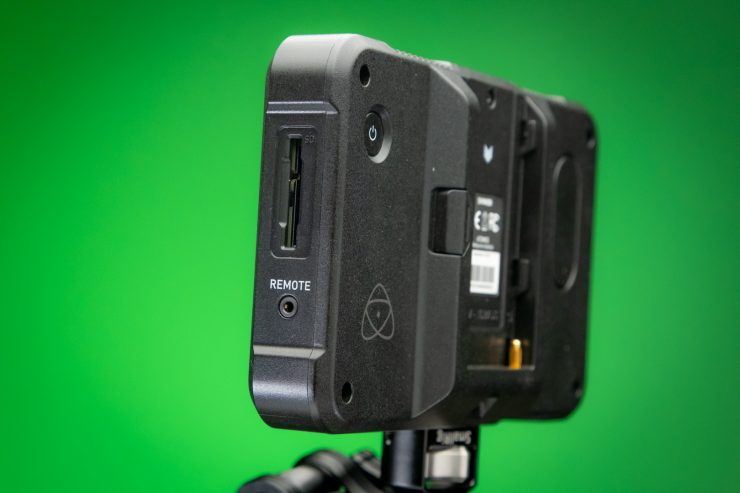
With most, if not all monitors in the sub $400 range they won’t have LUT and HDR support. This is a very nice option and one that is so handy to have if you shoot in LOG or HDR. The Shinobi has both.
Keeping it cool
The Shinobi doesn’t have a fan. If it does I can’t hear or see one. The monitor does have three vents. Two on the top and one on the bottom to keep it cool.
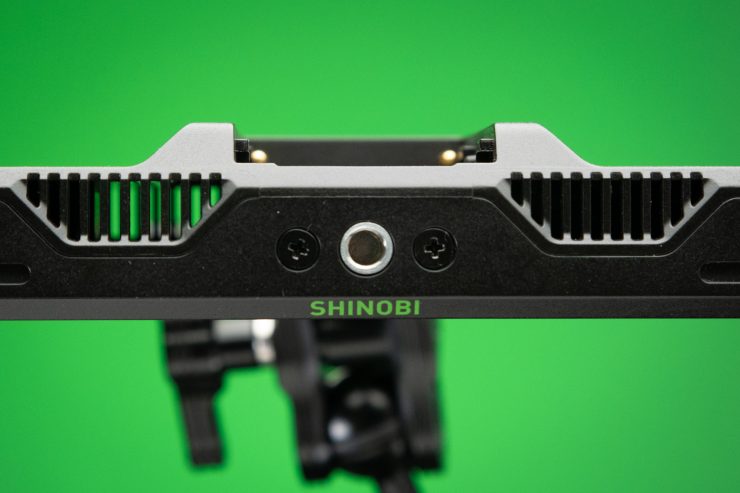
I can see right through the vents and also see the main circuit board inside and that does have me concerned. I’m not recommending using the Shinobi in bad wet weather or in a dirty dusty environment as particles will fit between the vents. I know I personally don’t shoot in such bad situations however if you’re a news or documentary shooter you never know where you will be shooting but it is something to be aware of to protect the monitor. From what I can see no fan is inside the Shinobi and that’s a good thing not to have fan noise to interfere with sound capture and that’s a big plus.
Battery life
Batteries are the bane of our existence. We need to be charged up and ready to go for every shoot. Lights camera and monitors all use batteries and sometimes all three are different. The good news with the Shinobi is the batteries last much longer than any other Atomos recorder because it doesn’t have to power a recorder.
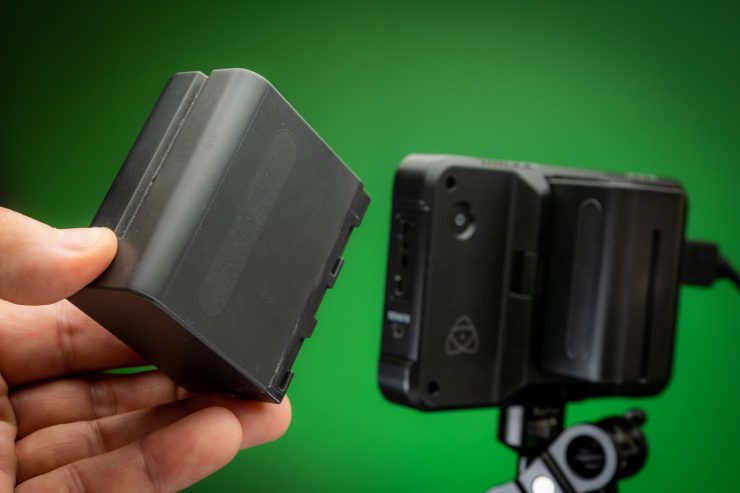
I decided to downgrade my NP-F970 to the Wasabi medium-sized NP-F770 4900mAh 35.5Wh. It’s more compact and a little lighter than the larger NP-F9870 model.
BATTERY LIFE BASED ON 7.4V
| 2600mAh | 2 hours 30 minutes |
| 5200mAh | 5 hours+ |
| 7800mAh | 8 hours+ |
As you can see the performance is pretty good and I can easily get by with three batteries in a day. Need to be super compact? the smallest version is the NP-F570 2600mAh 18.7Wh. with four or five your set.
Conclusion
The Atomos Shinobi is a real bargain with pro features that will work great on any camera with an HDMI output. You now have an SDI option too that also includes an HDMI input. I would get the SDI version since I do use cameras that have this connection plus it also has an HDMI input however if you are mainly using it with hybrids or the HDMI option on a cinema camera saving $100 isn’t a bad thing. At $399 for HDMI and $499 for the SDI model, you get a lightweight monitor with many pro features. You don’t see this very often. You also don’t see many monitors in this price range that support LUT’s and HDR support. I think the Atomos Shinobi is going to be a very popular monitor for pros and enthusiasts alike.

